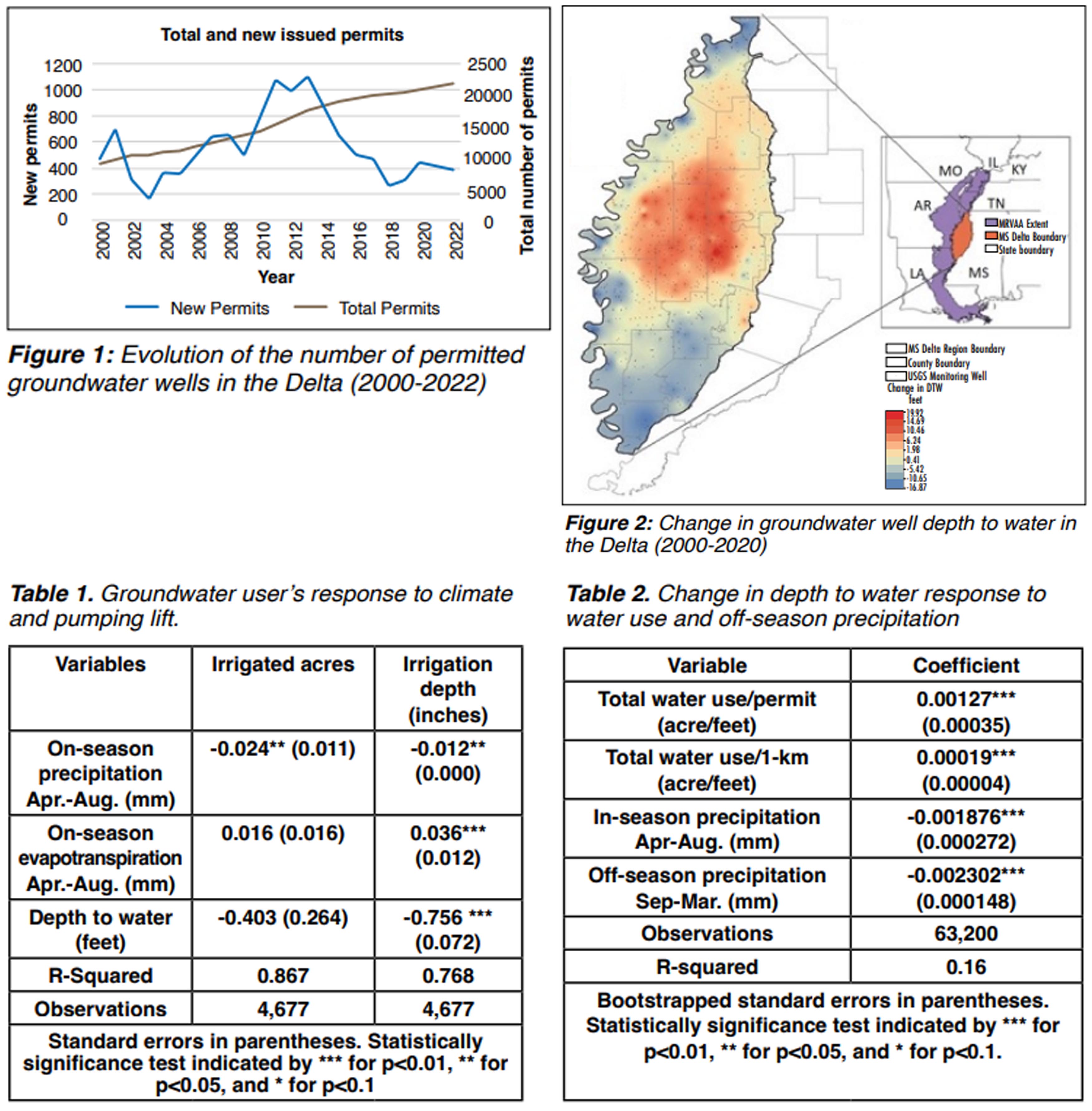Research Project
Exploring the role of off-season precipitation and irrigation water use in inter-season changes in well depth to water
Investigators: Amer Al-Sudani, Nicolas E. Quintana Ashwell, and Drew M. Gholson
Date: 2022
Project Summary
Introduction
The Mississippi Delta Region (Delta) receives over 52 inches of rain during the year, on average, but most of that precipitation occurs outside the growing season. Consequently, the region depends on irrigation to sustain agricultural production. The number of permitted wells increased from about 10,000 to over 21,000 between 2000 and 2022 (Mississippi Department of Environmental Quality), with rates of newly permitted wells of between 178 (2003) to more than 1,100 (2011-2013)-see Figure 1. Pumping from the Mississippi River Valley alluvial aquifer (MRVAA) exceeds its rate of recharge, which has led to declining water levels of between 2 feet to more than 13 feet between the years 2000 to 2020 (Figure 2). We analyze weather and water use data to assess whether off-season rainfall mitigates aquifer depletion.
Groundwater's User Response to Climate and Depth to Water
We quantify the change in groundwater well depth to water (at the start of the season) due to user's reported past groundwater use and off-season precipitation using field-level data on over 1,900 wells over the 2014-2017 period. First, we estimate producer's groundwater use given seasonal aquifer and weather conditions, including total groundwater use, irrigated acreage and amount of groundwater applied per acre-see Table 1 for regression results.
Groundwater users adjust the amount of water applied per acre and their total water use in response to changes in weather and aquifer conditions. In terms of irrigated acreage, the data suggests producers reduce the actual irrigated acreage with increased evapo-transpirative demand. Based on this regression analysis, we estimate groundwater use for all permitted wells in the Delta to understand the role of off-season precipitation in alleviating aquifer depletion. This first stage of analysis indicates that reported water use is sensitive to the depletion of the aquifer with average irrigation depth decreasing by a quarter-inch for every additional foot of pumping lift.
The Role of Water Use and Off-season Precipitation on Change in Depth to Water
The decline in groundwater level is a consequence of the expansion in total irrigated acreage and total groundwater use. However, the aquifer also depends on recharge from infiltration and percolation of precipitation. Therefore, off-season rainfall can curb groundwater depletion by restoring soil moisture profile and replenishing the aquifer. Our enriched dataset includes over 63,000 data points between 2014 and 2017 accounting for estimated total water use during the growing season and interpoFigure 1: Evolution of the number of permitted groundwater wells in the Delta (2000-2022) New permits Total number of permits Total and new issued permits Year 1200 1000 800 600 400 200 0 2000 2002 2004 2006 2008 2010 2012 2014 2016 2018 2020 2022 0 5000 10000 15000 20000 2500 New Permits Total Permits HYDROLOGICAL & SOCIOECONOMIC ANALYSES 2022 NCAAR ANNUAL REPORT 45 lated estimates of off-season precipitation along with a number of control variables (not reported). We regress the change in depth to water (inter-annual difference in depth to water measures) on estimated water use and preceding off-season precipitation (Table 2).
The results indicate that for every 100 acre-feet increase in pumping from a given well, the average change in depth to water increases by 0.13 feet-i.e., depletion accelerates by 0.13 feet per year. Similarly, a total of 100 acre-feet increase in pumping by wells located within 1 kilometer of a given well would be associated with the rate of depletion of that well accelerating by 0.019 feet per year. On the other hand, for every 4 inches (100mm) of additional off-season precipitation, the average rate of depletion decreases by 2.76" (0.23 feet). These effects indicate that aquifer conservation efforts involve a collective effect by which the actions from a given farmer affect other farmers.
Conclusion
The data confirms the intuition that greater water use speeds up depletion in every case while it also provides insights with respect to the role of off-season precipitation in alleviating depletion. The regression results indicate that off-season precipitation alleviates the rate of depletion of the aquifer. In terms of groundwater use, the results also indicate that collective action by farmers may be as important as individual action by farmers in conserving the aquifer given the statistically significant impact that pumping from neighboring wells have on the depth to water for any given well.
Project Photos

- Topic:
- Irrigation
Find Research
By Crop Type
By Topic
Contact NCAAR
General Information
Kaye Sullivan
vfs23@msstate.edu
662.390.8510
F:662.390.8501
Showcase Demo
Drew Gholson, Coordinator
drew.gholson@msstate.edu
662.390.8505
Himmy Lo
himmy.lo@msstate.edu
662.390.8509

